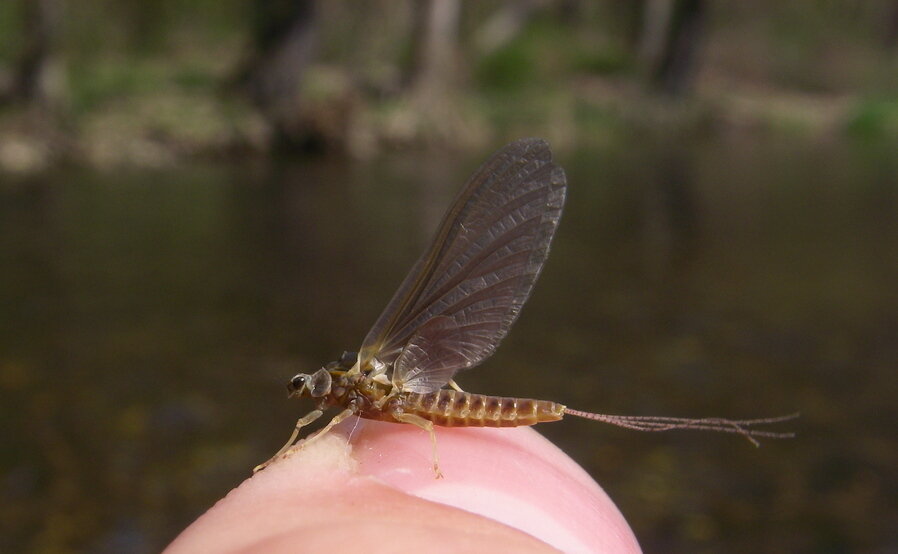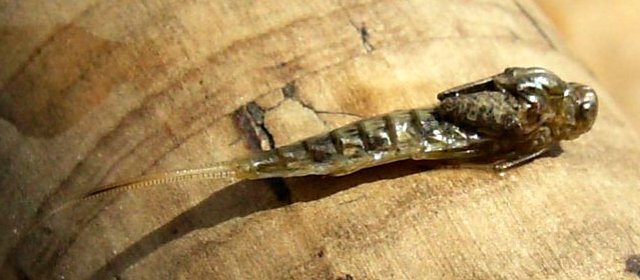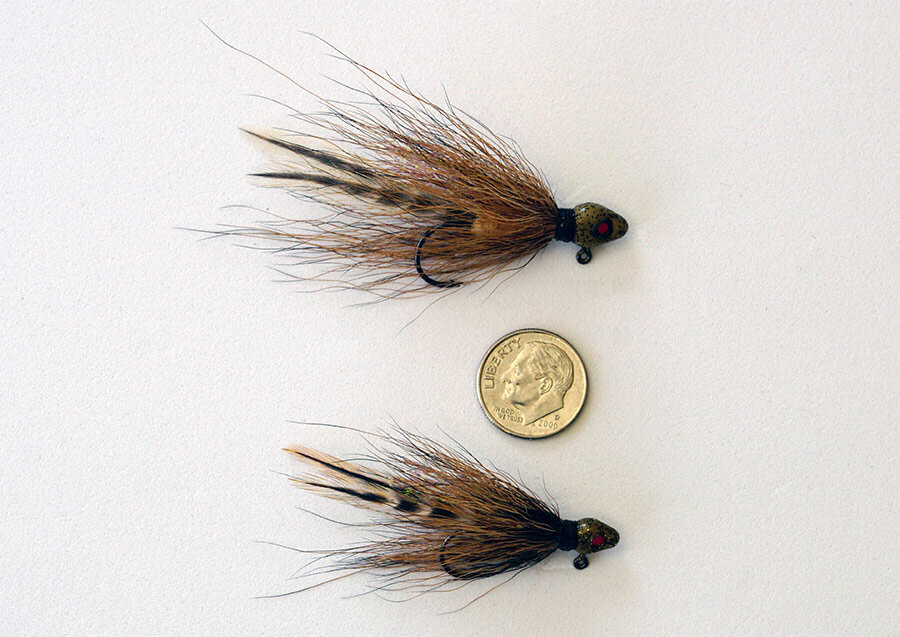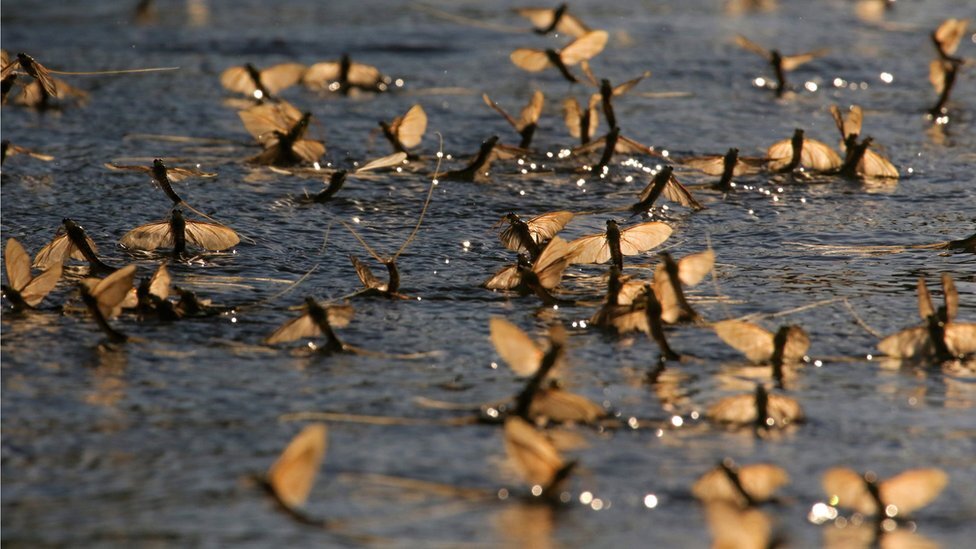The conventional anglers’ relationship with the Mayfly is much different than we see in the fly fishing world, often viewed as more of a nuisance than any real sign of great fishing to come. Despite this unfavourable reputation, the role that this ancient insect plays in our fisheries is substantial and the often-overlooked subsurface impact they have on walleye fishing, in particular, should put them on the radar of more anglers when heading out this spring.
Lifecycle of the Mayfly
Mayfly is an all-encompassing term that refers to any insect in the Ephemeroptera family. These insects are perhaps best known for their short lives and tendencies to fill waterways and the fish that inhabit them. However, there is a lot more going on beneath the surface than it may seem.
Nymph:
While the mayfly may live a mere two days above the water, the nymph stage of these insects’ life can last over one year. During this stage, nymphs can moult, or shed their skin, up to 50 times depending on the species and environment, a process unique to this ancient family of insects.
Subimago (Dun):
When the moulting phase is complete and the nymph has grown to its full size, the mayfly begins its first major transformation. During the final moult, occurring when water temperatures rise above 40 degrees, the nymphal skin begins giving way to a winged fly, often called a dun or emerger, and will begin making its way towards the surface. After dodging feeding fish and reaching the open air, the subimago mayfly heads for safety in nearby trees and grasses while they await their final transformation.
Imago (Adult/Spinner):
After a few days of rest, the subimago goes through one final moulting period and completes its transformation into a fully-grown and sexually mature mayfly.
Soon after, the mayfly will hit the skies, joining millions of other flies in a multi-day orgiastic flying session thick enough to form buzzing clouds over the waterways that play host. Once their mission has been accomplished, male mayflies happily meet their end and leave the females to deposit their eggs and slowly meet the same fate.
This late hatching phase leaves the surface of the water littered with dead and dying insects, providing a seemingly unlimited amount of food for scavenging fish and plenty of competition for anglers to contend with.

Fishing the Pre-Mayfly Hatch
Timing and Location:
Although many are unaware of it, much of our early season walleye fishing takes place during a time when Mayflies are a staple of the fish’s diet. Throughout much of Canada, walleye fishing begins in May when the fish are finishing up their spawn and are heading back into their typical feeding behaviours with their minds finally cleared. While their name may suggest that the skies would be full of Mayflies as their eponymous month begins, changes in climate and the 18th century’s shift away from the Julian calendar now see the Mayflies begin their hatches in late May/early June.

Since mayflies are not quite in flying form in early May, this period often sees hungry post-spawn walleye gorging on late-stage nymphs that have begun to emerge from their silty haunts.
Mayfly nymphs tend to hide out along soft bottom areas where they burrow themselves in sand and silt and hang out among structure and vegetation. During mid-May, however, their emergence from the silt coupled with the warming of these shallow areas bring walleye into these soft-bottom flats by the hundreds and a feeding frenzy ensues.
Mayfly nymphs begin to emerge when water temperatures reach roughly 46 degrees. A good fish finder will come in handy when searching out these warm pockets, however, looking for dark bottom composition and focusing your efforts on the northern parts of the lake will be a good way to get started.
As mentioned above, these nymphs emerge almost exclusively from soft bottom areas so look for light-coloured bottoms on your graph or use a light action rod to get a feel for the structure you are fishing. Fishing in the early mornings and late evenings is also a good idea as mayflies rarely emerge in rough water, limiting some of the best activity to when things are calm and flat.
Baits:
Once you have located the area, it is time to consider your bait. Thanks to the walleye’s relentless appetite this time of year, the mantra of “match the hatch” doesn’t quite hold as much water as it does during other seasons. That being said, getting your bait as close as possible to the real thing is well worth the effort when these feeding frenzies are taking place and can really give you the edge when angling pressure starts to rise.
Since many of the best mayfly imitations are seen in fly shops, conventional anglers will often borrow these patterns during the early season. To provide a similar presentation while still maintaining enough weight to cast on conventional tackle, these mayfly patterns are tied onto weighted jigheads, commonly referred to as hair jigs.
As seen below, these jigs are often tied on very small heads, often 1/8 of an ounce, in order to provide the most realistic presentation possible. If you’re looking to tie them yourself, these jigs require little more than a jighead, maribou, and some brown or black bucktail.

When fishing these baits, it is important to use light tackle as the subtle weight of the jig and the even subtler taps from the walleye will be difficult to detect on heavier gear. I try to stick with at least a medium-light rod for this style of fishing (preferably a light) and a 6-8lb fluorocarbon line for my leader. This lightweight setup will allow you to work the jig along the structure and subtly bounce the jig throughout the silt while still picking up on any abnormalities that might signify a striking fish.
Powering Through the Peak Mayfly Lull

Nothing quite gets a guide sweating more than floating in a client-filled boat through clouds of dead mayflies on the way to a once productive spot. While many would assume that the abundance of dead mayflies on the surface would be a positive thing for anglers, this couldn’t be further from the truth.
As mentioned at the beginning of the article, mayflies die shortly after depositing their eggs and do so, by the thousands, at the exact same time. This phenomenon leaves clouds of fly carcasses floating on the surface of the water, providing fish with an overabundance of food that becomes almost insulting after a few days of gluttonous feeding.
Trying to compete with this food source is a difficult task and thankfully, unless you’re a guide, no one is forcing you to attempt it. When fishing recreationally, it is often best to abandon these areas altogether and head to locations where fish will be more appreciative of what you have to offer. One of the best places to find these more grateful fish is on the offshore humps.
Though typically reserved for summertime, these deep pieces of structure will host plenty of large female fish during the late spring as they rest from the spawn and feed on large, soft-rayed baitfish. Focusing on the shallower humps, rising to around 15 feet or so, will be your best bet during the early season before the fish begin their descent down to 20 and 30 feet when water temperatures really start to heat up.
If you are, for some reason, forced to fish in areas where the hatches have just occurred, you will be best to simplify your presentation with live minnows, worms, and leeches. Fish will still hit when an abundance of mayflies are around but every dead bug will be viewed as competition so try to use brighter colours on your jigs to stand out. If fishing is really tough, bobbers are always a fail-safe, despite the reputation you may gain amongst friends when fishing one.
Conclusion
The mayfly hatch my have rightfully earned its reputation as a tough time to fish, but that is no reason to sit at home! For those who are willing to put in the effort or move off of their favourite spring spots, some big fish will still be waiting for you this season, no matter how many bugs you have to wade through to get to them.
